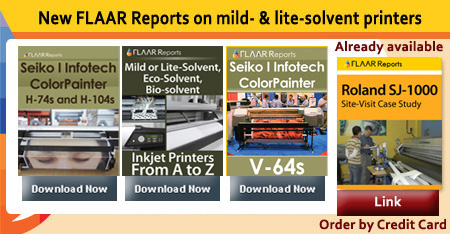Introduction to the Gerber Orion solvent ink printer, for printing with solvent-based inks on vinyl for outdoor signs which don't need lamination.
Our first view of the Gerber Orion was at the SGIA sign trade show in November, 2000. Gerber had just taken over this printer and it was not quite ready. Since January 2001 the printer is in production and available.
All the trade magazines clearly specify the Gerber Orion as the former ANAgraph SpectrumJet, also known as the Arizona 30. ANAgraph itself has been purchased by Gretag and will specialize in vinyl cutters and other products. Gerber will sell and be responsible for the Gerber Orion.
The Gerber Orion is a solvent based ink printer. This implies comparison with other solvent based printers such as the Mutoh Tomahawk (the renamed Mutoh Albatross). Solvent-based ink printers have the advantage of printing on economical materials such as vinyl. Signs printed on vinyl with solvent based inks can hold up outside in the sun and rain for at least three years with no lamination.
Solvent based inks may require a vent. The inks have a noxious smell though the inks used in the Gerber Orion are nowhere near as unpleasant as those used in the grand format inkjet printers.
Solvent based inks don't work in thermal printhead systems (such as ColorSpan, Hewlett-Packard, or Encad). This means you don't get photo-realistic quality at close viewing distances with any solvent based ink system (at least not yet). Signs printed with solvent based inks are intended to be viewed from far away, such as a billboard. At these distances you don't notice the systematic banding which is characteristic of these printers. I have yet to ascertain whether the banding is inherent in Xaar printheads or the other piezo printheads. Banding is a major defect in Epson piezo-electric printheads, most notably in some Roland printers.
Xaar piezo printheads, as well as all printheads for grand format printers (Gerber Orion is only 62" and hence not grand format), can only achieve low dpi. Images are also sort of soft focus. The banding seems to have a dark side and a light side. Yet in a sign filled with intricate detail (known as a busy scene) you do not notice the banding. Indeed at 10 foot viewing distance you don't see the banding at all. Close up, however, the image lacks precise detail and hence would seem inappropriate for wallpaper or any signage where viewers come close.
The Gerber Orion is solidly constructed. This I had an opportunity to notice when visiting the manufacturing plant. Overall this is the most basic printer I have yet seen. There is not very much on this printer that could go wrong. We don't yet have any end-user reports but the fewer gizmos that a printer has, the less can go wrong with it. The Gerber Orion is gizmo-less. This is how they get the price lower than other solvent ink printers. I gather the list price is in the $40,000 range.
Be sure to consider the following factors when you decide on a printer for signs, namely speed. If you earn your living by mass production of signage you will need a printer that can produce lots of material quickly. This is not the intended market for this printer. The Gerber Orion is an entry level solvent ink printer.
Since it has Xaar heads it would seem its native resolution is 360 dpi. I saw 720 dpi in the brochure but it was not labeled as "apparant resolution." I will have to check on that. I have not yet seen any image from a Xaar printhead that is true 720 dpi, but then again, Epson's native resolution is 720 and they accomplish an apparant resolution of 1440. Apparent resolution on Epson and thermal printhead machines, however, are acceptable because of the lack of banding defects at these higher resolutions. Xaar printheads can not yet achieve such detail. Xaar printheads are basic workhorse technology but for images to be viewed from a distance, such as billboards.
No matter which brand of printer you are considering for your signs, this is your hard-earned money you are about to invest. You should consider asking for one of the FLAAR reports on sign printers before you make your decision. We have read the brochures of many of these printers and submit the advertising claims to the real-world test of reality. So if you wish a reality-check to find out what some of the printers can really do, just ask for any of the FLAAR reports; they are available at no cost.
For additional information and for help making your decision, ask for the "FLAAR report on signs, posters, banners" (specify whether for indoor signs or outdoor signs in the rain and sun) or for the FLAAR report on "Piezo vs Thermal printheads, fact vs fiction, pros and cons of each kind of inkjet printhead." You can also ask for the report on "Media and Inks for Photo-Realistic and Fine Art Giclee," or "Media and Inks for Sign Printing with Large Format Inkjet."
If this will be your first printer, then we have a special report that holds your hand and leads you through all the basic questions that will assist a first-time buyer of a large format printer. Purchase the FLAAR report on "RIP + Help." This explains what RIP software is, why this is useful, and includes tips, warnings, information, and help for a wide range of matters for a newbie. Here you will really appreciate that FLAAR is based at a university; Professor Hellmuth has plenty of experience writing in a manner that explains what you need, and why.
Most recently updated August 02, 2001.
 |